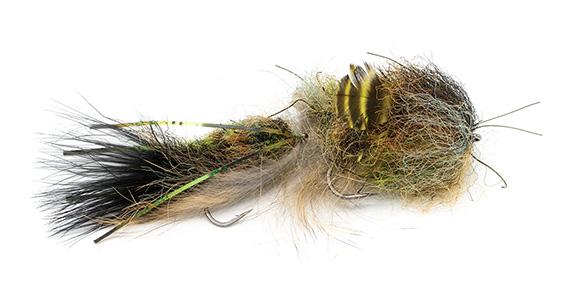Hog Heaven
Tying the Wally's Pool Pig.
When I’m asked about sculpins, a few things always come to mind. They have fat pectoral fins, they lack an air bladder so they can’t maintain their position in a water column without effort, they live in nearly every trout stream, and trophy brown trout can’t get enough of them, especially in the winter.
To catch your limit, try using a Wally’s Pool Pig. It uses a heavy head, mottled colors, large pectoral fins, and a trimmed shape to provide a jig-like action for stripping or a perfect profile for dead-drifting. When the water is cold, it’s all about calories in versus calories out, and for big browns, a beefy sculpin is an easy, high-calorie meal. Put this fly under an indicator or slow-strip it along the bottom this winter. Either way, hold on!
Materials
Thread: Any GSP 100-denier in black
Hooks: Ahrex Trout Predator size 2 in front; Ahrex Trout Predator size 4 in back
Cone head: Alaska Brass Cone in gold
Tail: Black blood quill marabou
Body: EP Crustaceous Brush in sculpin color
Under body: 1/8” rabbit strip in natural color
Legs: Fly-enhancer legs in chartreuse/olive/black
Pectoral fins: Soft hackle hen patch in olive
Articulation: 20# Rio Bite Wire and olive 3D bead
Instructions
1. Tie in the marabou tail about two times the length of the hook shank. Tie in the crustaceous brush at the bend of the hook. Palmer the crustaceous brush up the length of the hook shank, taking care to brush out fibers along the way to avoid trapping them. Tie off the crustaceous brush and whip finish.
2. Brush out the crustaceous brush fibers and trim them to form a small cigar-shaped body. Start the thread at the head of the hook. Tie in two rubber legs on each side of the body. Pierce the rabbit strip on the hook point leaving 1/4” of hide off the back. Pull the rabbit strip to the front of the hook and tie it off underneath. Whip finish and add head cement.
3. Place a large Alaskan cone head the hook. Build the articulation. Tie in the crustaceous brush at the bend of the hook and palmer it forward to about 3/4 of the hook shank, taking care to not trap the fibers. Whip finish and trim the crustaceous brush so that it tapers down nicely to match the back hook’s taper.
4. Place the hook back in the vice and tie in the pectoral fins on each side of the body. Pierce a second rabbit strip, leaving1/4” of hide off the back end. Pull the rabbit strip forward and tie it off still at 3/4 the way up the hook shank. Whip finish.
5. Push the cone head back against the pectoral fins and body. Tie the crustaceous brush in right in front of the cone. Palmer four wraps of crustaceous brush in front of the cone. Tie down the brush and whip finish. Leave the front wraps shaggy and don’t trim. Add head cement.
Jake Walbridge is the general manager at Montana Troutfitters.












